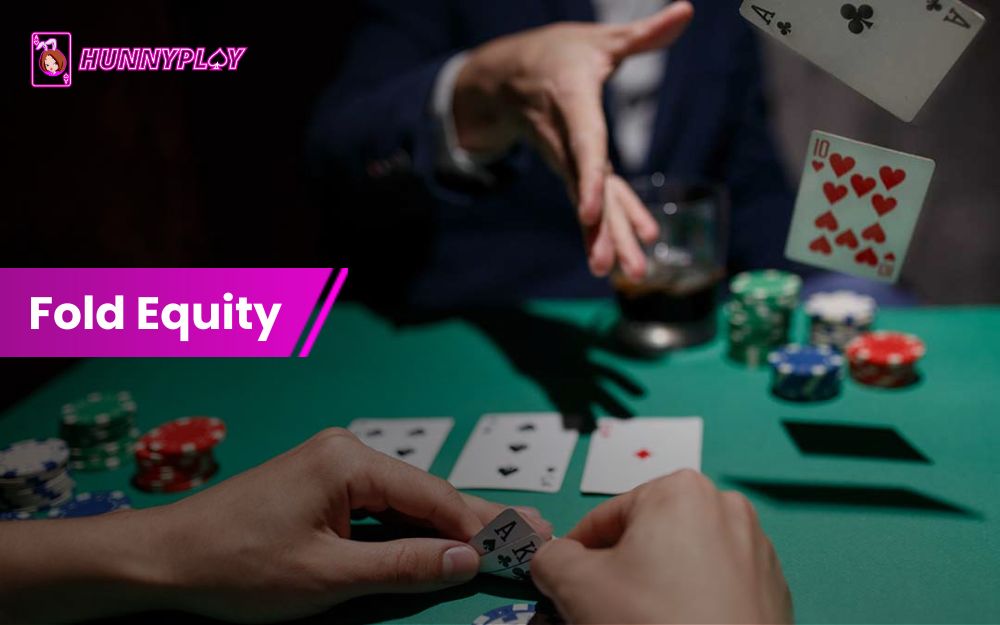Fold equity in Poker is the advantage you gain when your bet or raise compels an opponent to fold, allowing you to win the pot without a showdown. In this article, HunnyPlay will explain this concept and its significance in maximizing your winnings at the tables.
What is Fold Equity?
Fold Equity refers to the likelihood that an opponent will fold in response to a bet or raise. Every time you place a bet in Poker, there’s a possibility that your opponent will fold. When they do, you win the entire pot regardless of your hand’s strength.
This likelihood of an opponent folding boosts your overall equity. It offers an extra opportunity to claim the pot, beyond merely relying on having the best hand at showdown.
Each time you bet with the chance of a fold, you add extra equity to your hand. Think of your overall equity as a combination of Fold Equity and hand equity:
Total Equity = Fold Equity + Hand Equity
If your opponent always folds, you can’t lose and thus have 100% equity. When your bet gets called, your hand has equity based on its chances of winning the pot.
Hence, total equity combines Fold Equity and the equity of your hand when called.
To understand Fold Equity simply, consider these points: “How much it do we have?”
- If an opponent is likely to fold to your bet, you have high Fold Equity.
- If an opponent is unlikely to fold, you have low Fold Equity.
- If an opponent will never fold, you have no Fold Equity.
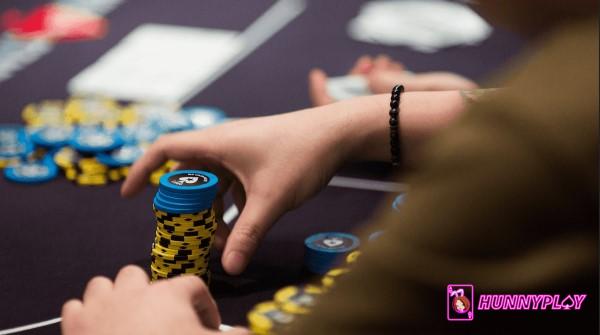
Fold equity is the probability that an opponent will fold when faced with a bet or raise. (Source: Internet)
Why does it matter?
Fold equity is crucial for forming optimal strategies at every stage of the game. When you lack a strong hand, considering it helps you make decisions that maximize expected value (EV).
The primary use of Fold Equity is in executing profitable bluffs. For instance, if you have a bluff with 0% equity, it must succeed more often than the risk-to-reward ratio of your bet to be profitable.
Understanding and leveraging Fold Equity allows players to turn seemingly weak hands into winning strategies. By considering how often opponents will fold, you can increase your overall profitability and make smarter betting decisions.
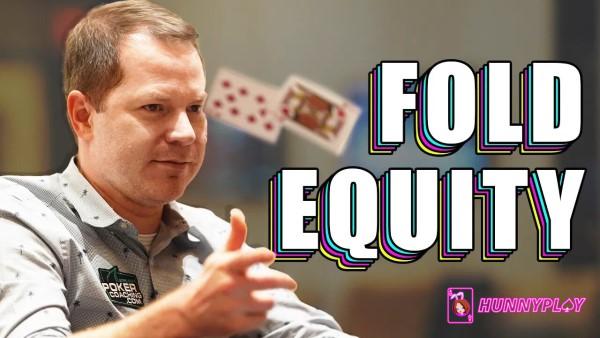
Fold equity is essential for crafting optimal strategies at every stage of the game. (Source: Internet)
In-depth understanding Equity in Poker
The mathematical basis of this concept
Fold Euity is a critical concept in Poker, influencing your strategy on every street. When you place a bet, you’re essentially absorbing some of your opponent’s equity if there’s a chance they will fold. This additional equity can be calculated using a straightforward equation:
Fold Equity = (Chance our opponent will fold) * (Opponent’s equity in the hand)
The likelihood of your opponent folding is based on your understanding of their tendencies. For instance, through experience, you might determine that your opponent folds 75% of the time in specific scenarios.
Your opponent’s equity is simply the percentage of the pot they expect to win by the river. It’s essentially the equity of their range but let’s keep it simple for now.
Your total equity combines your current equity with your Fold Equity, providing a comprehensive view of your potential to win the hand. On its own, it may seem trivial, but when combined with your standard equity, it becomes significant.”
Determining profitable bluffs
One of the most crucial uses of Fold Equity is in determining profitable bluffs. For a bluff with 0% equity to be profitable, your Fold Equity must exceed the risk-to-reward ratio of your bet.
Risk-to-Reward Ratio formula:
Risk-to-Reward Ratio = [Bet Size / (Bet Size + Pot Size Before the Bet)] x 100
In shorthand: Risk-to-Reward Ratio = [B / (B + P)] x 100
Example in action
- Suppose you bet $50 into a $100 pot:
- Risk-to-Reward Ratio = [50 / (50 + 100)] x 100
- Risk-to-Reward Ratio = 0.33 x 100
- Risk-to-Reward Ratio = 33%
In this scenario, for your $50 bet to be profitable with 0% equity when called, you need more than 33% Fold Equity in the long run.
Balancing equity
The more equity you have, the less Fold Equity you need for a profitable bet. This dual-win scenario means you can either hit your hand or force a fold, enhancing your overall strategy.
Understanding and leveraging it can significantly impact your game, turning marginal situations into profitable opportunities.
By integrating this concept into your play, you can maximize your winnings and make more informed decisions at the table.
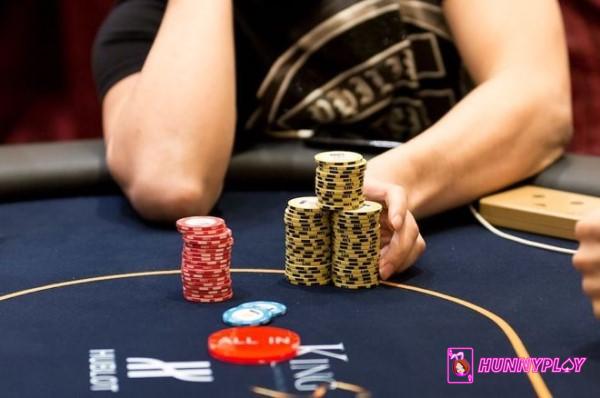
Equity in Poker shapes optimal strategies by helping you make the highest EV decisions when you don’t have a strong hand. (Source: Internet)
Fold Equity infographic
Explore this informative infographic detailing this concept required for 6 different bet sizes based on your hand’s equity when called:
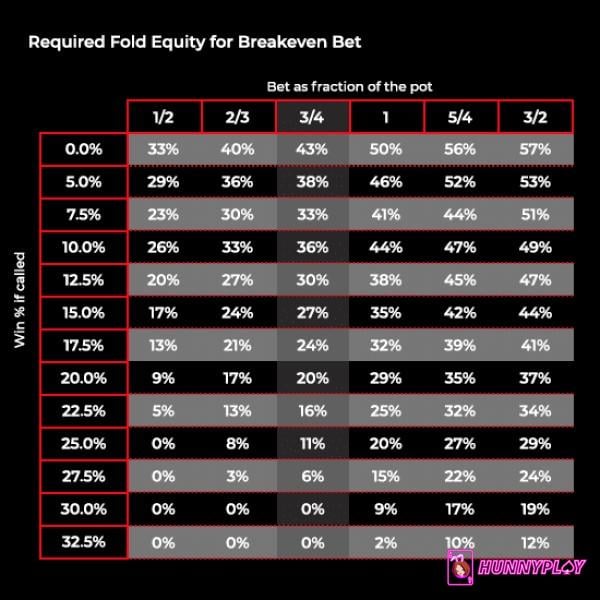
Source: upswingPoker
For instance, if you place a 3/4 pot bet with a hand that has 0% equity when called, your opponent needs to fold more than 43% of the time for your bet to break even.
Understanding these percentages is crucial for optimizing your betting strategy and making profitable decisions at the Poker table.
The benefits of Fold Equity
“Fold equity is the reason why semi-bluffs can be profitable.” It is the driving force behind successful semi-bluffs. Most often, you’ll leverage Fold Equity when betting or raising with a flush or straight draw.
Typically, these draws lack sufficient equity to justify calling bets and raises on their own.
However, by being the aggressor, the addition of it can tip the overall equity in your favor. Over time, well-executed semi-bluffs with drawing hands will prove profitable.
For a deeper dive into this topic, read our article on playing drawing hands aggressively.
Pure Bluffs and Fold Equity
The profitability of a pure bluff hinges almost entirely on Fold Equity. Without any equity based on your hand’s strength, you depend solely on it to make the bluff worthwhile. For instance:
- Board: Qs Kh 2s 8s 2d
- Our hand: 9s Ts – 0% equity
- Opponent’s hand: Kd Js – 100% equity
In this scenario, unless you believe your opponent will fold at least 50% of the time, your bluff won’t be profitable.
Your Fold Equity equals your total equity here (as current equity is 0%), so if it’s below 50%, you’ll lose more money than you win in the long run.
Understanding and utilizing it is crucial for making informed betting decisions and enhancing your overall strategy at the Poker table.

Equity in Poker is the reason why semi-bluffs can be profitable. (Source: Internet)
Fold Equity – FAQs
Q: What does fold mean in gambling?
A: To fold means to discard your hand and forfeit any interest in the current pot. No further bets are required from the folding player, but they also forgo any chance of winning the pot. Folding can be indicated verbally or by discarding your hand face down into the muck or pot (though the latter is uncommon).
Q: How to determine Fold Equity?
A: The classical definition of Fold Equity is: EV = (how often they fold) x (size of the pot).
Q: Do I lose money when I fold in Poker?
A: No, folding does not cost you any additional money. However, it means you cannot win any money either. Once you fold, you are out of the hand, and any money you previously bet into the pot remains for the remaining players to contest.

Understanding and leveraging equity allows players to turn seemingly weak hands into winning strategies. (Source: Internet)
Conclusion
Understanding Fold Equity is crucial for improving your poker strategy. It allows you to leverage opponents’ tendencies and enhance your overall equity in a hand.
By mastering this technique, you can make more informed betting decisions, turn marginal situations into profitable ones, and refine your bluffing techniques.
For more insights and advanced strategies, visit HunnyPlay and elevate your poker game to the next level.




















